Visual Search: How To Build A Better Shopping Experience
Find out how incorporating visual search and product discovery can transform your shopping journey to increase your average order value per transaction
For all the ways e-commerce has improved the quality of our shopping experience, there’s still a painful gap between inspiration and product discovery that doesn’t feel as organic as it does in a brick and mortar store.
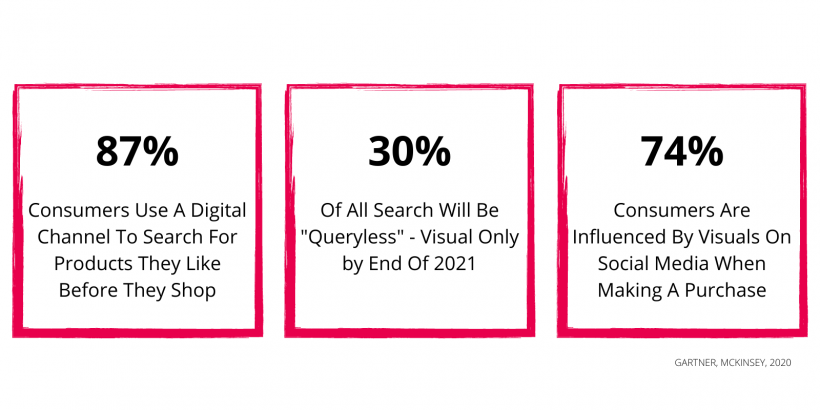
Moreover, we are often inspired by new complete outfit looks or style themes rather than a specific product that can be put down to text.
When we are shopping in the physical world, we rarely start with text. Product discovery offline is in fact deeply visual and starts by looking not typing. Visual search brings that sense of organic discovery to the online shopping experience to bridge the divide between inspiration and purchase.
“ Being able to search the world around you is the next logical step ”
– Brian Rakowski, VP Product Management, Google
What Is Visual Search
MIT discovered that 90% of the information that comes to the human brain is visual. Visual search and product discovery is the e-commerce solution that makes our intrinsic way of operating one and the same with the way we shop. When a customer performs visual search, or image-based search, they look for one or multiple products using an image instead of keywords. Visual search uses real-world images (screenshots, social media images, or photos) as the stimuli for online search and product discovery.
Your visitors can upload any form of an image of a product or outfit they like. The visual search engine will then find the visually closest products from your online catalogue. Also, it will make suggestions of other visually similar items that they might like based on their image enquiry.
In the rapidly reduced attention spans of digital shopping journeys, visual search capabilities allow you to capture the imaginations of customers with minimum work and friction on their end.
How Does Visual Search Work
Visual search requires A.I. feature detection and pattern matching.
Machine learning and A.I. computer vision technologies that run in the background will scrutinize the uploaded image first to analyze shapes, colors, and patterns. Afterwards, it will do the same with your entire product inventory images to rank those items that resemble the uploaded image from closest to farthest. This works by mapping each image to a coordinate in a high-dimensional space, where similar items have coordinates which are closer together and dissimilar items have coordinates which are farther apart. With all images mapped to this space, finding items that are similar becomes as simple as finding which coordinates are the closest to the coordinates of the item of interest.
The number of results you show to your customers can be easily customised to your needs. However, it is important to remember that shoppers like choice as long as it is tailored and relevant to their intent. The A.I. will keep learning your individual customer’s intents and preferences. As they interact more with your store, their visual search recommendations will become more personalised.
How Can You Personalise Visual Search Results
Let’s imagine that two different customers uploaded this image:
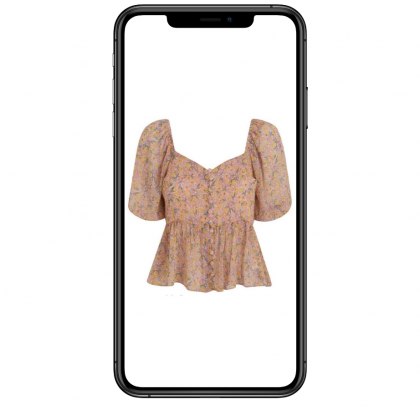
This top has three defining attributes:
- It is Floral print
- It is Button-down
- It has Puff Sleeves
If you do not have a near-identical product to show in your in-stock inventory, the A.I. will know your different customers’ intents. Meaning that based on the collected knowledge from their past interactions, the A.I. can tell:
Customer A uploaded this because they liked the puff sleeves compared to Customer B who uploaded it because they liked the floral print and colour palette.
While Customer A’s visually similar product recommendations will feature more puff sleeve options from your stock, Customer B’s recommendations for the exact same image will include more floral prints in this colour palette. The customized search results will further increase the probability of product discovery resulting in a purchase.
Even when you don’t have the matching items in your stock!
Why Visual Search When There Is Text-Based Search
Visual search enables retailers to suggest products that are stylistically or thematically related to the customer’s shopping intent in a way that they are struggling to deliver using traditional text-based enquiries alone.
The differentiating value of visual search is that it can kindle the imagination, then capture and fuel the resulting purchase intent with almost 100% accuracy. Let’s look at why text-based search and product discovery fail to do this as accurately.
Again, let’s assume that two different customers who have seen this dress in a magazine want to find a very similar product from your stock.
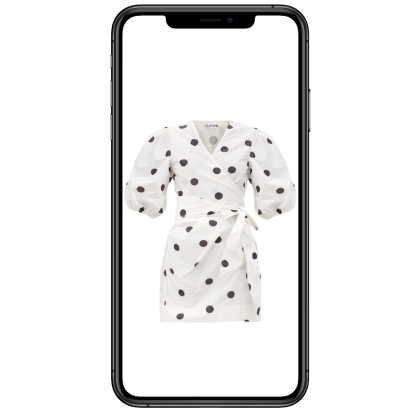
This dress has a number of defining attributes:
- It is Polka-dot print
- It is a Wrap dress
- It is a Mini dress
- It is a Puff Sleeve dress
- It is a Short Sleeve dress
- It is a Ruched dress
- It is a Black & White dress
Can you imagine a search enquiry saying: “ polka dot, wrap, mini, puff sleeve, short sleeve, ruched, black, white dress ”
What will likely happen is:
While Customer A will define “wrap dress” as the keyword, Customer B will judge it to be “puff sleeve dress”. Meaning that neither customer will immediately find what they are looking for.
The Issue With Search Keywords
Even assuming that the customer has actually gone to the trouble of listing all attributes they want to find correctly, there is a very good chance that the returned results will still not be exactly what they are looking for – or worse, they will get no results.
The reason is: The keywords that they are using might not match the product attribute or tag names that you are using on your metadata.
Baymard Institute’s e-commerce search usability study tested the experience of the shoppers of 19 major e-commerce websites. The study concluded that:
“ 70% of websites require users to search by the exact jargon for the product type that the website uses, failing to return relevant products for ‘blow dryer’ if ‘hairdryer’ is typed ”
– Baymard Institute E-Commerce Usability Test
This is an especially problematic area in fashion and apparel retail where the taxonomy isn’t unified. Fashion taxonomy varies drastically not only across shoppers from different regions but also individual retailers within the same region.
And while there are other solutions we can tailor to make your text-based search experience easier and improve your product discovery results, where words fail, the only way forward is to go visual.
Do You Have To Choose Between Text and Visual Search
No, you don’t! In fact, you can combine the benefits of both styles of search.
A combined approach means your customers get the best shopping experience of their life and you can show them the most accurate products that they want to see every time. One way of combining text and visual search is to have both search styles as standalone options for your customers to choose from.
The more enhanced way of combining visual and text search elements is allowing your customers to upload an image for visual search but also give them the option to support the image with text.
“ 55% of consumers say visual search is instrumental in developing their style and taste ”
This can be provided in the form of a product category dropdown where the customer chooses which category they want to see results for. Alternatively, you can include a text search bar that accompanies the image upload button for visual search.
What Are The Different Ways Of Visual Product Discovery
1- Single Product Discovery
Single product visual search allows your customers to upload either a single product image or a full-body image to get visually similar results for just one product they’re interested in.

Here, the visitor has uploaded the full-body outfit image of an influencer to find a similar product to the tote bag she’s wearing.
2- Outfit Discovery
Outfit discovery is the ultimate use case for visual search to reach its full revenue-boosting potential. Meanwhile, this approach delivers the best user experience for your customers. Shoppers can upload full-body images and get product recommendations for every single item on the image they upload.
A.I. and visual recognition technology separate the outfit into individual products. Next, the A.I. separately matches each one to the closest visually similar items from your catalogue. Eventually, it recreates the full outfit look using your own stock in a matter of seconds.
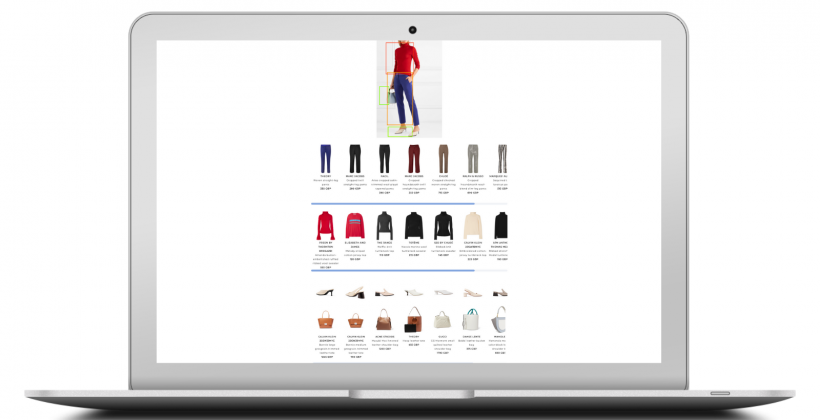
Showing shoppers the entire look that has inspired them allows you to up-sell multiple items instead of just one. Outfit recommendations significantly increase Basket Size and Average Order Value (AOV). On the other hand, your customer gets higher satisfaction from the visual search experience.
What Are The Direct Benefits Of Visual Search For Your Business
1- Immediate Path From Inspiration To Product Discovery
By collapsing the steps between inspiration and product discovery, you can significantly decrease purchase failures. A.I. powered visual search eliminates the friction between seeing and buying, creating a seamless shopper journey.
In fact, studies show that visual search leads to checkout twice as quickly as text-based search.
2- Smooth and Fast Conversion
Text-based search, even when supported by impeccable filters, can be a long and tiring process. Somewhere along the line, the shopper might just give up because it simply is too much effort. Visual search and product discovery put exactly what your customer wants to see right in front of them in a matter of seconds, without any browsing or scrolling involved.
Consequently, site abandonment rates are reduced meaning that your visitors convert into paying customers in a fraction of the time of traditional product discovery.
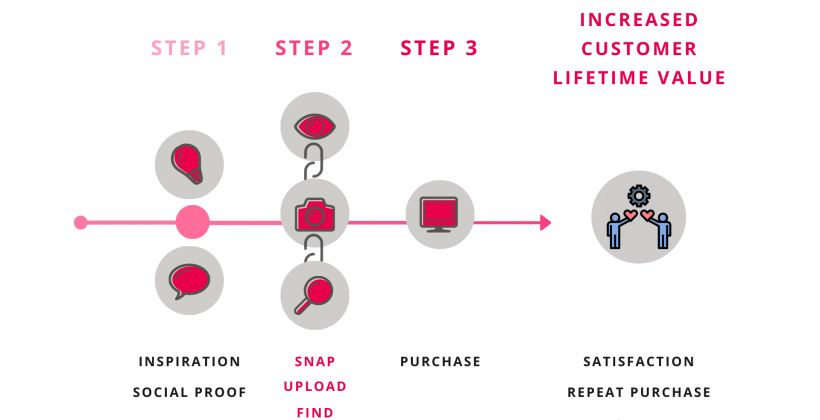
3- Integrated Online and Offline Experiences
Multi-channel shopping journeys don’t necessarily have to mean your own-brand retail channels.
Visual search can drive traffic from online and offline product discovery on hundreds of different platforms – even down to snapping a product your friend is wearing from some past collection of a different retailer – right back to your online store.
This means that your retail business can benefit and profit from the inspiration that may originate from anywhere!
4- Capitalize Social Proof and Word-Of-Mouth
97% of consumers will do a visual inspiration research online before making a purchase – even when shopping in a brick and mortar store using their mobile.
According to McKinsey & Co. and the Business of Fashion, nine out of ten shoppers trust an influencer more than traditional advertisements or branded endorsements. This, alongside peer reviews (55%) and social media (74%) largely impact purchase decisions.
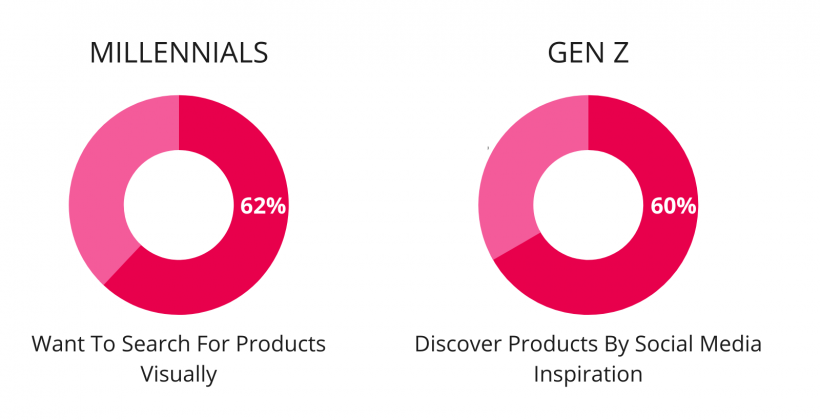
Unlike previous generations, 60% of Gen Z shoppers discover products on social media, while 62% of Millennials report that they want the ability to search and discover products using images that inspire them. Capitalising on the inspiration that is readily taking place without any content or resource production on your part means that you can grow your overall sales without any additional marketing effort and cost.
5- Less Noise During Product Discovery
One of the most complained e-commerce features is the crowded noise of irrelevant products that shoppers have to sort through in order to find a single product that they want to purchase. Remember we said shoppers like options when tailored to their needs? Conversely, when they are bombarded with options that do not meet their requirements, the end result is quite devastating for a retail business.
A shopper who can’t find the right products through the noise of options will not only leave your online store to browse a competitor’s, but they will likely not return to an uncomfortable shopping experience again.
By cutting out the irrelevant noise, visual search allows your customers to conduct a targeted and goal-driven product discovery that has a significantly higher ratio of resulting in purchase.
6- Tracking and Measuring Success Easily
As opposed to the challenges of linking text-based searches to purchase, if a customer uses visual search and goes on to buy that product (or one of the similar alternatives), it is easy to trace that sale back to the visual search. A retailer can see when shoppers click on visual search results, which styles they clicked on, and most importantly, at what point they made the purchase.
The practical implication of this is simple:
You can identify the exact products and product categories that consistently receive attention and convert, allowing you to double down on efforts that drive results.
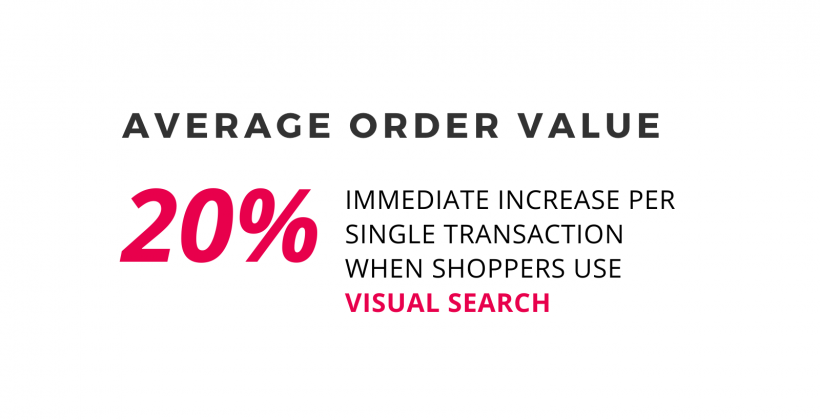
7- Better Understanding of Customer Behaviour
Visual search will give your business the most clear and objective understanding of what your individual customers and different customer segments are looking for when they shop.
Through their visual search enquiries, you will gain a deeper understanding of their taste, purchase drivers and motivations.
This invaluable information can then be channelled into your marketing efforts as well as inform your product mix allocation and buying decisions based on what your customers are more likely to want and buy.
8- Increased Customer Lifetime Value
Customer Lifetime Value is the most important asset a retail business can acquire that will continually keep growing their revenue.
Think about the shoppers that visit your store with these three common consumer dilemmas:
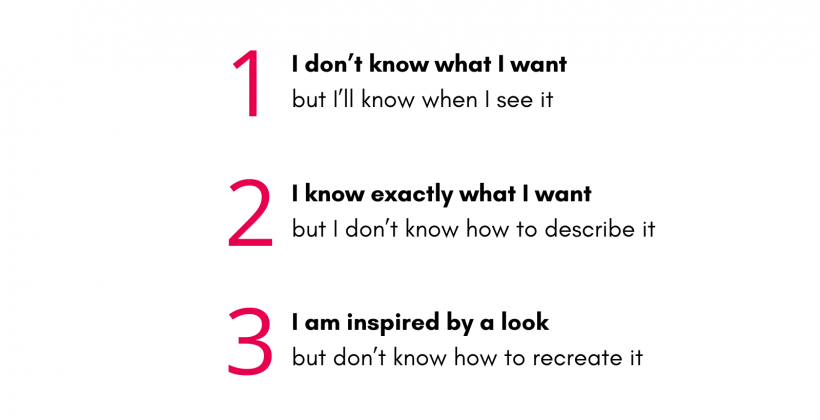
By allowing your customers to discover products via visual search, you are essentially listening to their pain points and providing them with the most intuitive solution for finding the products they want from your store in their own terms.
When you facilitate a shopping journey rather than dictate the steps, your consumer satisfaction will skyrocket – meaning that your shoppers will always return to you for more.
Final Thoughts
Customers who have an easier time finding the products they are looking for are already multiple steps closer to making a purchase.
The rapid adoption of visual search will lead its market value to $14,727 million by 2023, growing at CAGR 9%.
“ Visual search removes hurdles, taking the customer directly from inspiration to gratification ”
– Wanda Gierhart, Neiman Marcus, CMO
Gartner research forecasts that by 2021, early adopters of this technology that redesign their product discovery experience to support visual search will increase their e-commerce revenue by 30%.
Get in touch today to find out how we can help you integrate visual search into your e-commerce shopping journey and be among the pioneering retailers who will enjoy immediate revenue growth.
Book a free consultation


